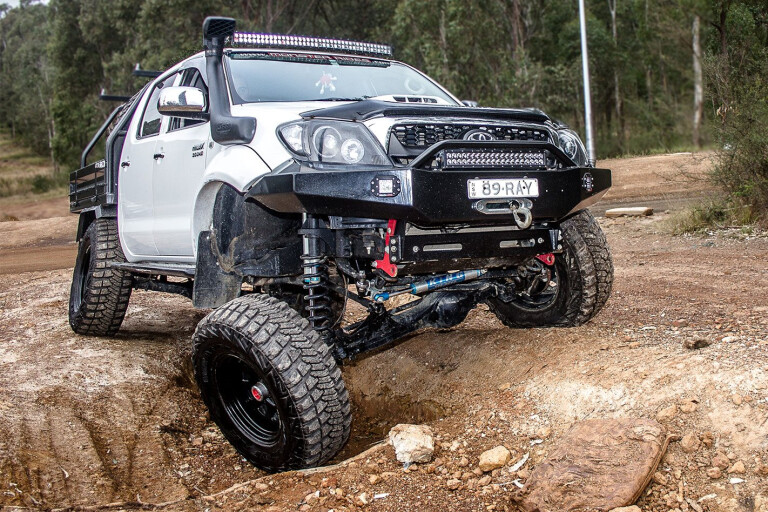
AS IS THE case every year, we’ve received a lot of feedback regarding our 4x4 Of The Year decision. While many readers wholeheartedly agree with our call to award the Toyota Land Cruiser 79 Double Cab the 4X4OTY award, many others have questioned how a vehicle that originally hit the market more than 30 years ago could be considered for such a prestigious gong, especially when up against the latest all-new, high-tech 4WDs.
Of course, the 70 Series Land Cruiser has been significantly updated over the years, with chassis and engine upgrades now accompanied by a host of electronic driver aids and safety features, but it’s still not as ‘high-tech’ as all-new vehicle designs. But is high-tech what you want out in the bush? Despite its shortcomings we reckon the Land Cruiser 79 is one of the best bush-touring vehicles on the market, and it’s becoming a rare old beast: one of the last old-school 4WDs still on the market.
So what’s better: traditional or high-tech? Let’s look under the skin.
MONOCOQUE VS SEPARATE CHASSIS
ALL modern cars and a number of modern four-wheel drive wagons feature monocoque construction, where the chassis and the body of the vehicle are incorporated into one structure. There are several advantages to designing and building a vehicle in this way: they are relatively light compared to vehicles with a separate body-on-chassis design, so offer better performance and improved fuel economy; they have greater torsional rigidity, offering improved ride and handling on the road; and they are generally safer vehicles because crumple zones around a rigid passenger cell can be more easily incorporated into their design.
While these are important advantages, many four-wheel drives on the market still have a body-on-separate-chassis design, and for good reason.
From a vehicle manufacturer’s perspective, the primary advantage of a separate chassis design is the ability to easily platform share. In the case of one-tonne utes, manufacturers can simply bolt different body structures atop the same separate chassis to create single, extra and double cab variants of their one-tonne utes, and then throw tubs, trays or service bodies on the back to suit customer requirements. Many go one step further, having developed wagon variants using the same chassis designs, such as Ford Everest, Toyota Fortuner, Holden Trailblazer, Isuzu M-UX and Mitsubishi Triton, all of which use the same basic chassis as their ute siblings. In the case of the 70 Series Land Cruiser, Toyota has for many years used the one chassis design for Single Cab, Double Cab, Wagon and TroopCarrier variants, simply adjusting chassis length as required.
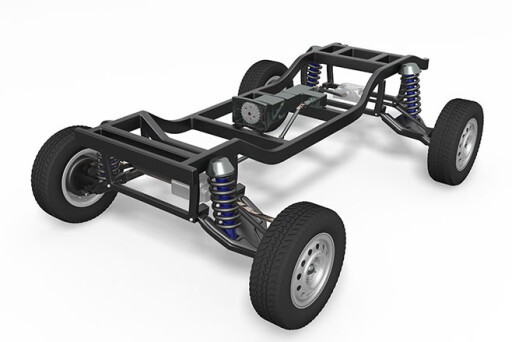
From a four-wheel driver’s perspective, there are several advantages to the traditional separate chassis design, such as chassis flex and road noise insulation. While it doesn’t do any favours to on-road dynamics, chassis flex is beneficial off-road when a vehicle is crawling over obstacles and can aid the suspension’s ability to keep all four wheels on the ground over undulating terrain.
“You can get a really strong monocoque construction in any vehicle, but the vehicles I tend to choose for off-road travel, like GU Patrols, 70 Series Cruisers and Land Rover Defenders, all have a separate chassis,” said Ron Moon, 4X4 Australia’s Editor-At-Large.
As well as off-road strength and flexibility, a separate chassis allows for more options when fitting accessories. 4X4 Australia’s Road Test Editor Fraser Stronach explained: “You’ve got room to put [fuel] tanks and water tanks, and a solid place to mount a bullbar.”
INDEPENDENT VS LIVE-AXLE SUSPENSION
NOWHERE is the tech versus tradition debate more obvious than when comparing modern independent suspension systems with old-school live-axle arrangements.
By definition, an independent suspension allows each of a vehicle’s wheels to act independently of each other. In other words, if a wheel hits a bump, it has no direct effect on the opposing wheel, unlike a live-axle arrangement where opposing wheels are directly joined via the solid axle between them. The other advantage of an independent suspension is it has less unsprung weight, so the springs and dampers are more easily able to control up and down wheel movement. Both of these attributes provide on-road ride and handling advantages over a heavy, live-axle suspension set-up.
Some examples of 4WDs with fully independent suspension include the Mitsubishi Pajero, Jeep Cherokee and Grand Cherokee, and Land Rover Discovery and Range Rover.
Many manufacturers like to have an each-way bet and equip their vehicles with independent front suspension and a live axle at the rear. Examples include the current crop of one-tonne utes, and wagons such as Toyota 200 Series Land Cruiser and Prado. But is this a good solution?
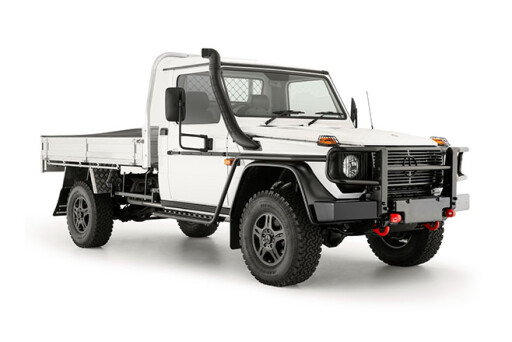
“It depends on your driving mix,” said Stronach. “The standard Toyota 200 Series/Prado with the independent front and live-axle rear is probably the right thing… but a fully independent vehicle can be a good thing, as the Land Rover Discovery has proven since 2003.”
When the going gets tough off-road, however, a live-axle set-up has advantages over an independent design, including constant ground clearance under the axle and the fact that as one wheel is pushed upwards by an obstacle the opposing wheel is pushed downwards, giving the vehicle more chance to keep all of its wheels on the ground.
“Independent suspension is fantastic for any road – a bitumen highway, a dirt road or a gravel road – but once you start to get into the really rough stuff I think the live axle tends to operate better,” said Moon.
4X4 Australia’s Editor Matt Raudonikis added: “You can’t beat live axles for off-road use, and unfortunately they’re dying out. The newer [independent suspension] systems try to make up for it with clever electronics to give you some traction when wheels are being picked up off the ground, but for off-road use you can’t beat live axles front and rear.”
With the recent demise of the GU Patrol and Land Rover Defender, the only four vehicles left on the market with live axles front and rear are the 70 Series Land Cruiser, Jeep Wrangler, Mercedes-Benz G-Class and the tiny Suzuki Jimny, so vehicle options for the four-wheel drive tourer are diminishing.
“There are so many electronic aids now which [enhance off-road performance] that it’s becoming less of a dramatic difference,” pointed out Moon.
Having said that, Moon isn’t a fan of the complex electronics on modern 4WD vehicles: “I’m a bit old school. I tend to like [a separate] chassis and no electronics for the remote driving I do. What electronics there was on my GU [Patrol], which was only the security system for the doors and all that sort of stuff, I ripped out! So I’m a bit of a troglodyte mate.”
ELECTRONIC VS MECHANICAL TRACTION AIDS
A MODERN vehicle with a full suite of electronic traction aids will include traction control, stability control, hill descent control, trailer sway control and more, so there are a raft of obvious benefits when it comes to everyday driving compared to an old-school vehicle with nothing bar a couple of mechanical diff locks. But when it comes to serious off-road bush driving, are electronic traction aids up to the job?
“Electronic traction aids all work on the brakes and the vacuum reservoir and they have a finite time they can operate for in really hard going,” said Moon. “I’d much rather have a mechanical diff lock which is locked when you press a button and unlocked when you repress the button.”
Stronach agreed: “It depends on your driving mix. I mean ultimately mechanical lockers [for off-road use], but for convenience electronic stuff is fantastic.”
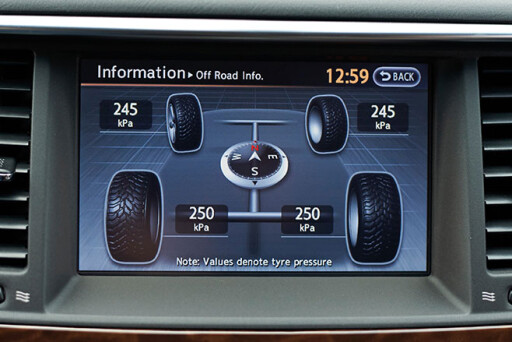
When it comes to traction aids, you can have your cake and eat it too; many modern four-wheel drives are now available from the manufacturers with both electronic traction control and a mechanically locking rear differential.
“The ultimate is the combination of both,” said Raudonikis. “Electronic traction control gives you every day driving around gravel roads, and for this it works really well. But having the ability to switch on a locker for when the going gets tough works far better; traction control will only get you so far.
“With newer vehicles we’re getting more lockers from the factory, plus you can have aftermarket ones, and that’s the best combination,” he said. “You’ve only got to go back 10 years or so when the one-tonne utes didn’t have electronic traction control in them, and they were totally useless.”
LOW-PROFILE VS HIGH-PROFILE TYRES
ONE of the easiest ways for manufacturers to improve a vehicle’s on-road handling is by eliminating the vagaries of tyre sidewall flex by fitting large-diameter wheels with low-profile rubber. Another advantage of this is they can fit bigger brakes within the confines of large diameter rims, essential for big, heavy vehicles with engines that produce once-unimaginable power and torque peaks.
But low-profile tyres are not good off-road; they are prone to sidewall damage, and the lack of space between the wheel and the ground can result in damage to the wheel. Additionally, there’s not a hell of a lot of choice when it comes to low-profile off-road rubber.
While an old-school high-profile tyre will exhibit more sidewall flex when cornering on the road, the off-road benefits are many: less chance of damaging a wheel; less chance of sidewall damage; better “bagging” of the tyre when air pressure is reduced to aid off-road traction in slippery conditions such as sand and mud; and better tyre choice for off-road conditions.

“All the new tyre spec on most vehicles is bloody hopeless,” said Stronach. “In the bush you want as much sidewall as you can get, light truck construction and a low speed rating; you don’t need a high-speed rating because high-speed tyres are built more fragile [lighter construction for better heat dissipation], even though that seems like a contradiction in terms. Up to 17s and 18s are fine now, but anything north of an 18-inch wheel and your tyre choice and bush practicality goes out the door.”
With ever-increasing on-road performance and demands for better on-road handling, the vehicle manufacturers are not going to revert to 15- and 16-inch wheels on their modern high-tech 4WDs, but it’s still possible to run decent rubber with a larger diameter wheel. “As Nissan has proven, you don’t have to go low profile to have big wheels,” said Raudonikis. “They’ve got 18-inch wheels on the [Y62] Patrol and it’s got a big, heavy sidewall on it; up to an 18-inch wheel is probably as tall as you want to go, but 16s are still better for off-road use.”
ELECTRONIC INJECTIONS VS MECHANICAL INJECTION
WHEN it comes to engine technology, the only way you can keep it simple is to buy secondhand; all new vehicles have high-tech electronically controlled engines in order to meet emissions legislation.
“Unfortunately there’s no real question here; because of emissions regulations you’ve got to have the high-tech engine,” said Stronach. “For ‘fixability’, if you’ve got an old-school mechanical diesel then you’re right, but there’s not many of them around; you can’t buy them, they’re all worn out or they’re getting worn out.”
While modern high-tech electronically controlled engines are generally far more reliable than their mechanically injected counterparts, that’s of no consolation if something goes wrong in the bush.
“In 45 years of touring the country, the only time I’ve ever had to be recovered was when an electronic box failed,” said Moon. “There was just no way we could get that to work and I had to get recovered.
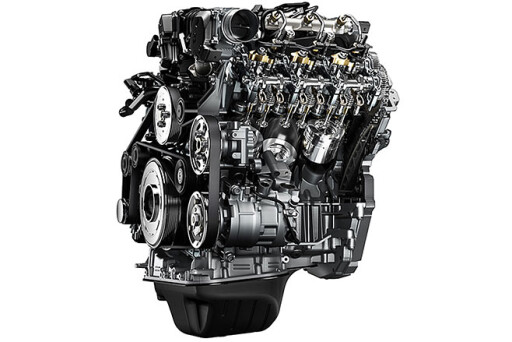
“Prior to that, somebody in the group has always been able to fix [any mechanical problem],” continued Moon. “Now you mightn’t be able to get it working perfectly but you can get the thing to run… especially with a diesel that’s got a fairly basic pump system and basic injectors. I carry a spare set of injectors if anything like that happens or if I get a gutful of crook fuel, but with electronics the fuel has got to be really good these days, and that’s the thing, just the quality of fuel has got to be better for these high-tech engines, and any sniff of water or anything like that, that really stuffs them.”
Raudonikis agreed that traditional mechanical injection is the best solution for remote-area outback travel. “It is, yeah, you can get it fixed almost anywhere,” he said. “It’s easier to diagnose, and if you can’t do it yourself most bush mechanics can, they can diagnose it and fix it, or at least jury rig it to keep you on the road. You give them the electronic stuff and they don’t even have the equipment to diagnose it. Electronics can be more reliable, they keep going longer and require less servicing, but when they do go wrong you’re screwed.”
A HIGH-TECH FUTURE?
SO WHAT does the future hold for the traditional old-school four-wheel driver? Well, if you’re a fan of a separate chassis, live axles front and rear, 7.50R16 rubber and a mechanically injected diesel engine, it doesn’t look too bright. In fact, the future for diesel engines is starting to look quite dim altogether, with ever-stricter emissions regulations being touted around the world.
“We’re bound to see more turbo-petrol engines coming in,” predicted Stronach. “Probably petrol engines in general, and probably even some bigger capacity ones. It’s just the way the emissions regulators have really changed sides on this whole debate, having gone from having diesels solving the problems of greenhouse gas to the petrol engine… generally small capacity, either turbocharged or supercharged… being better on NOx and particulates, the two problems that beset diesels.”
How will this affect the bush tourer? “Who knows?” questioned Stronach. “There’s a lot up in the air with forward emission regulations. I guess if you’re going to go touring in your petrol [four-wheel drive] you’ll just need a bigger fuel tank. Some of the modern vehicles aren’t too bad; the Haval H9 tested on 4x4 Of The Year wasn’t too thirsty.”
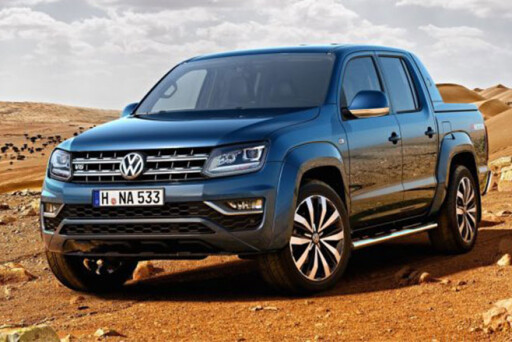
The seven-seat Haval H9 wagon has a high-tech 2.0-litre direct-injection four-cylinder turbocharged petrol engine that makes a respectable 160kW and 324Nm. It averaged 14.9L/100km on our 4X4OTY test, which included a mix of on- and off-road driving (the LC79 Double Cab used 13.8L/100km under the same conditions). And Haval has stated that it sees only petrol engines in its future model range.
“Haval has come out and said it’s not going to build diesel engines,” said Raudonikis. “There are more European countries where it’s very hard to keep diesel engines on the road; the manufacturers have already come out saying it’s going to get too expensive to keep updating diesel engines to meet emissions. So the modern petrol engines, with their direct injection and low-blow turbochargers, are making up that gap in terms of the torque down low. They’re much more drivable than the small, peakier petrol engines of old, but they still don’t have that long-distance drivability of a diesel engine when you’re out in the desert somewhere. Fuel vaporisation is also a problem.”
Is the end nigh for the diesel engine? “I was just reading a piece about London trying to ban diesels coming into the city, full stop,” said Moon. “I wouldn’t like to see it; diesel is the preferred fuel for outback travel, especially remote outback travel. Petrol engines might become more efficient as time goes on, but generally with low-speed work you tend to get better [economy] with a diesel… and diesel is also a lot safer fuel to handle when you’ve got it in drums.”
Hybrid vehicles and full electric vehicles have already made an appearance on Australian roads, but this technology is unlikely to become commonplace in four-wheel drives – at least in the foreseeable future.
“We’re yet to see any of that stuff yet, purely because they’re not reliable and capable enough off-road,” said Raudonikis. “Land Rover has got a bit of hybrid stuff happening, but no one has done any serious off-road touring with one. Yeah, it’s a real worry, it’s a big worry. It’s something you don’t want to go near.”
Stronach is also adamant that hybrid technology is not suited to four-wheel drives at this point in time and can’t see a future in the technology for bush tourers. “I think hybrids are a bit of a dud technology,” he said. “They work around town, but in terms of touring they’re a non-event. I don’t think they’ll have any impact on 4x4 designs. I mean, they’ll sell a few hybrids for people who want to drive them around town, as Range Rover does, but I can’t see it having any real effect.
“And I don’t think we’ll have to worry about autonomous cars if you’re going to ask about that, too,” laughed Stronach.
HIGH-TECH SAFETY
STRINGENT vehicle safety standards have had a massive impact on the demise of many traditional 4WDs and have influenced how modern vehicles are designed, developed, manufactured and marketed. These days, if a vehicle doesn’t achieve a five-star ANCAP (Australian New Car Assessment Program) safety rating, it quickly cops a thorough bashing by the general press and motoring media.
While most modern high-tech 4WDs achieve a five-star ANCAP rating, it’s almost unheard of for a traditional 4WD with a separate chassis and live axles to meet this standard… until Toyota threw big money at its ageing 70 Series workhorse to keep its commercial customers happy.
While only the Single Cab variant, popular with mining companies et al, scores the five-star ANCAP rating, the rest of the 70 Series range (Wagon, Troopie and Double Cab) have benefitted from a raft of upgrades (ABS, vehicle stability control, active traction control, hill-start assist control, brake assist and electronic brake-force distribution) to improve safety. This is good for bush tourers as the Land Cruiser is one of the last options available for those who want a traditional 4WD with dependable off-road capability.
“I think the Cruiser is a good blend of old and new,” said Raudonikis. “Toyota has done the absolute bare minimum to keep it on the road, but it’s still what we need. It does all the old-school things. It’s got live axles, it’s capable off-road, it’s got lockers, it’s got traction control, it’s got some safety features, but nothing you don’t really need.”
Moon agreed that four-wheel drivers need access to traditional vehicles without too much tech. “I think Toyota has done a pretty good job trying to keep the 70 Series current and viable in this modern age. Hopefully a couple of other manufacturers, like Land Rover, will do the same with the Defender replacement in the not too distance future.
“These vehicles are what we want to use when we go bush, and mining companies and station owners, they want tough, go-anywhere vehicles, and the less electronics the better… because once upon a time, a station owner could fix their Land Cruiser in their garage, but now it’s a matter of, ‘oh well, I’d better stick it on the truck and send it into town’.”

COMMENTS